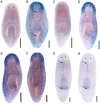Evolutionarily ancient association of the FoxJ1 transcription factor with the motile ciliogenic program
- PMID: 23144623
- PMCID: PMC3493443
- DOI: 10.1371/journal.pgen.1003019
Evolutionarily ancient association of the FoxJ1 transcription factor with the motile ciliogenic program
Abstract
It is generally believed that the last eukaryotic common ancestor (LECA) was a unicellular organism with motile cilia. In the vertebrates, the winged-helix transcription factor FoxJ1 functions as the master regulator of motile cilia biogenesis. Despite the antiquity of cilia, their highly conserved structure, and their mechanism of motility, the evolution of the transcriptional program controlling ciliogenesis has remained incompletely understood. In particular, it is presently not known how the generation of motile cilia is programmed outside of the vertebrates, and whether and to what extent the FoxJ1-dependent regulation is conserved. We have performed a survey of numerous eukaryotic genomes and discovered that genes homologous to foxJ1 are restricted only to organisms belonging to the unikont lineage. Using a mis-expression assay, we then obtained evidence of a conserved ability of FoxJ1 proteins from a number of diverse phyletic groups to activate the expression of a host of motile ciliary genes in zebrafish embryos. Conversely, we found that inactivation of a foxJ1 gene in Schmidtea mediterranea, a platyhelminth (flatworm) that utilizes motile cilia for locomotion, led to a profound disruption in the differentiation of motile cilia. Together, all of these findings provide the first evolutionary perspective into the transcriptional control of motile ciliogenesis and allow us to propose a conserved FoxJ1-regulated mechanism for motile cilia biogenesis back to the origin of the metazoans.
Conflict of interest statement
The authors have declared that no competing interests exist.
Figures




Similar articles
-
Systematic discovery of novel ciliary genes through functional genomics in the zebrafish.Development. 2014 Sep;141(17):3410-9. doi: 10.1242/dev.108209. Development. 2014. PMID: 25139857 Free PMC article.
-
The forkhead transcription factor Foxj1 controls vertebrate olfactory cilia biogenesis and sensory neuron differentiation.PLoS Biol. 2024 Jan 25;22(1):e3002468. doi: 10.1371/journal.pbio.3002468. eCollection 2024 Jan. PLoS Biol. 2024. PMID: 38271330 Free PMC article.
-
Foxj1 transcription factors are master regulators of the motile ciliogenic program.Nat Genet. 2008 Dec;40(12):1445-53. doi: 10.1038/ng.263. Epub 2008 Nov 16. Nat Genet. 2008. PMID: 19011630
-
[Transcriptional control of ciliogenesis in animal development].Biol Aujourdhui. 2012;206(3):205-18. doi: 10.1051/jbio/2012023. Epub 2012 Nov 22. Biol Aujourdhui. 2012. PMID: 23171843 Review. French.
-
Transcriptional control of genes involved in ciliogenesis: a first step in making cilia.Biol Cell. 2010 Jul 9;102(9):499-513. doi: 10.1042/BC20100035. Biol Cell. 2010. PMID: 20690903 Review.
Cited by
-
The compact genome of the sponge Oopsacas minuta (Hexactinellida) is lacking key metazoan core genes.BMC Biol. 2023 Jun 19;21(1):139. doi: 10.1186/s12915-023-01619-w. BMC Biol. 2023. PMID: 37337252 Free PMC article.
-
Transcriptome profiling of the dynamic life cycle of the scypohozoan jellyfish Aurelia aurita.BMC Genomics. 2015 Feb 14;16(1):74. doi: 10.1186/s12864-015-1320-z. BMC Genomics. 2015. PMID: 25757467 Free PMC article.
-
New class of transcription factors controls flagellar assembly by recruiting RNA polymerase II in Chlamydomonas.Proc Natl Acad Sci U S A. 2018 Apr 24;115(17):4435-4440. doi: 10.1073/pnas.1719206115. Epub 2018 Apr 9. Proc Natl Acad Sci U S A. 2018. PMID: 29632184 Free PMC article.
-
Gastric pouches and the mucociliary sole: setting the stage for nervous system evolution.Philos Trans R Soc Lond B Biol Sci. 2015 Dec 19;370(1684):20150286. doi: 10.1098/rstb.2015.0286. Philos Trans R Soc Lond B Biol Sci. 2015. PMID: 26554050 Free PMC article. Review.
-
An RFX transcription factor regulates ciliogenesis in the closest living relatives of animals.Curr Biol. 2023 Sep 11;33(17):3747-3758.e9. doi: 10.1016/j.cub.2023.07.022. Epub 2023 Aug 7. Curr Biol. 2023. PMID: 37552984 Free PMC article.
References
-
- Satir P, Christensen ST (2007) Overview of structure and function of mammalian cilia. Annu Rev Physiol 69: 377–400. - PubMed
-
- Ishikawa H, Marshall WF (2011) Ciliogenesis: building the cell's antenna. Nat Rev Mol Cell Biol 12: 222–234. - PubMed
-
- Fliegauf M, Benzing T, Omran H (2007) When cilia go bad: cilia defects and ciliopathies. Nat Rev Mol Cell Biol 8: 880–893. - PubMed
-
- Baker K, Beales PL (2009) Making sense of cilia in disease: the human ciliopathies. Am J Med Genet C Semin Med Genet 151C: 281–295. - PubMed
-
- Roy S (2009) The motile cilium in development and disease: emerging new insights. Bioessays 31: 694–699. - PubMed
Publication types
MeSH terms
Substances
LinkOut - more resources
Full Text Sources
Molecular Biology Databases

